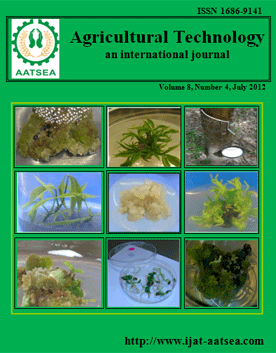ThaiScience
ThaiScience
INTERNATIONAL JOURNAL OF AGRICULTURAL TECHNOLOGY
Volume 18, No. 01, Month JANUARY, Year 2022, Pages 179 - 192
Adoption of integrated pest management (ipm) technologies in southern philippines: constraints and motivations
Josue-Canacan, D. R.
Abstract Download PDF
Determining the factors that influence farmers’ adoption of IPM is critical to a successful sustainable pest management program. This study was conducted to determine the constraints and motivations in IPM adoption, involving 112 farmer participants of a Two-year IPM Training program (Years 2018 to 2019) in Southern Philippines. Of the 40 adopted technologies, ten were affected by training attendance. Most of the adopted technologies belonged to the bottom tier of the IPM Pyramid, which are the abiotic actions such as crop rotation, adopted by 42 to 85% of the participants. Training completers had higher level of adoption, from moderate to very high, than absentees whose adoption were mostly from low to moderate. Learners of IPM-based pesticide use also adopted IPM technology at a higher level than non-learners. Motivations, such as increases farm productivity and income, highly influenced training attendance. Constraints influenced the level of adoption. Lack of time and capital were common constraints among the various adopters, from low to very high adopter types. Low to high adopters also indicated laziness as a constraint in IPM adoption. Thus, these constraints and motivations are important factors to consider in designing IPM training programs to encourage attendance to training and, eventually, adoption of IPM technologies.
Keywords
Adoption constraint, Adoption motivation, Integrated pest management, Technology adoptionINTERNATIONAL JOURNAL OF AGRICULTURAL TECHNOLOGY
Published by : Association of Agricultural Technology in Southeast Asia (AATSEA)
Contributions welcome at : http://www.ijat-aatsea.com
